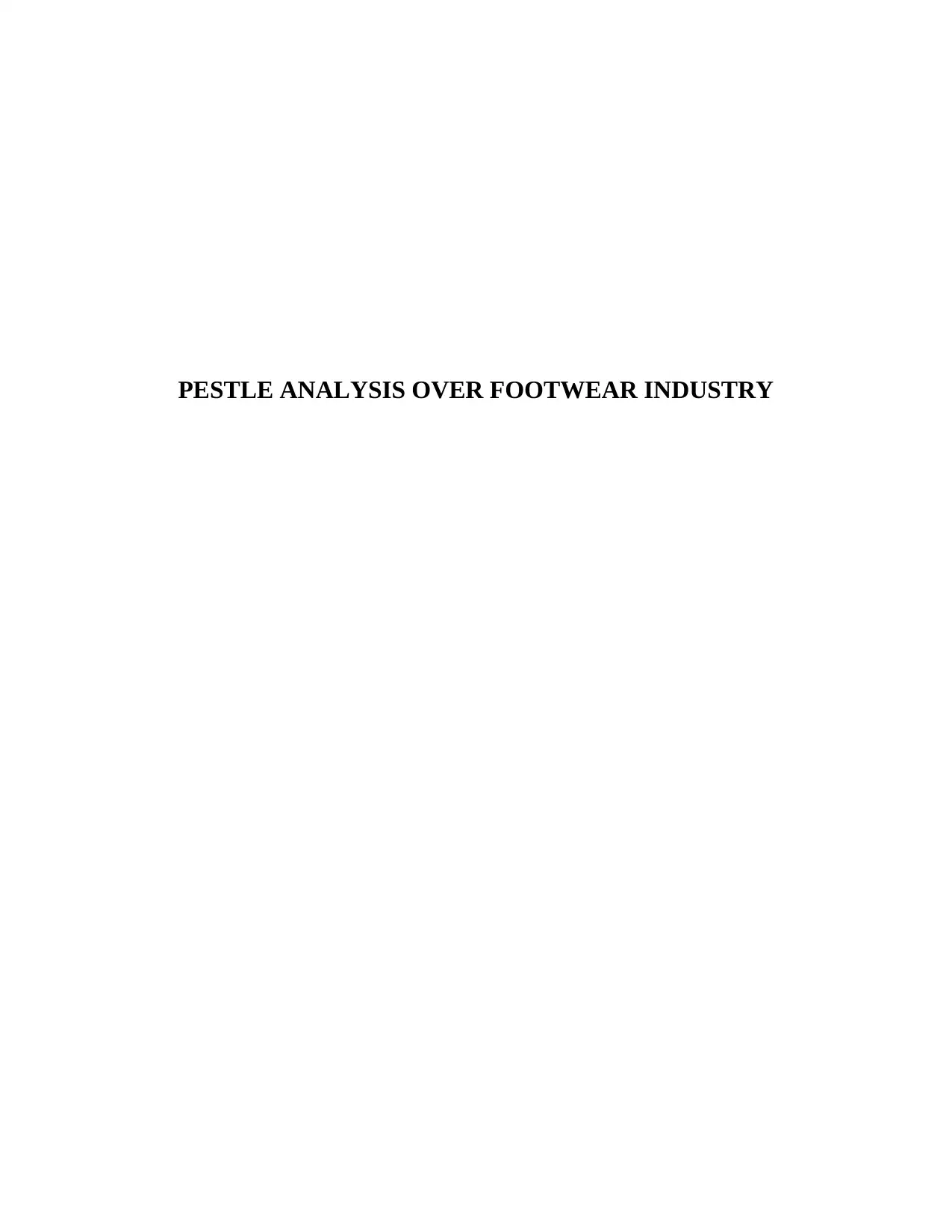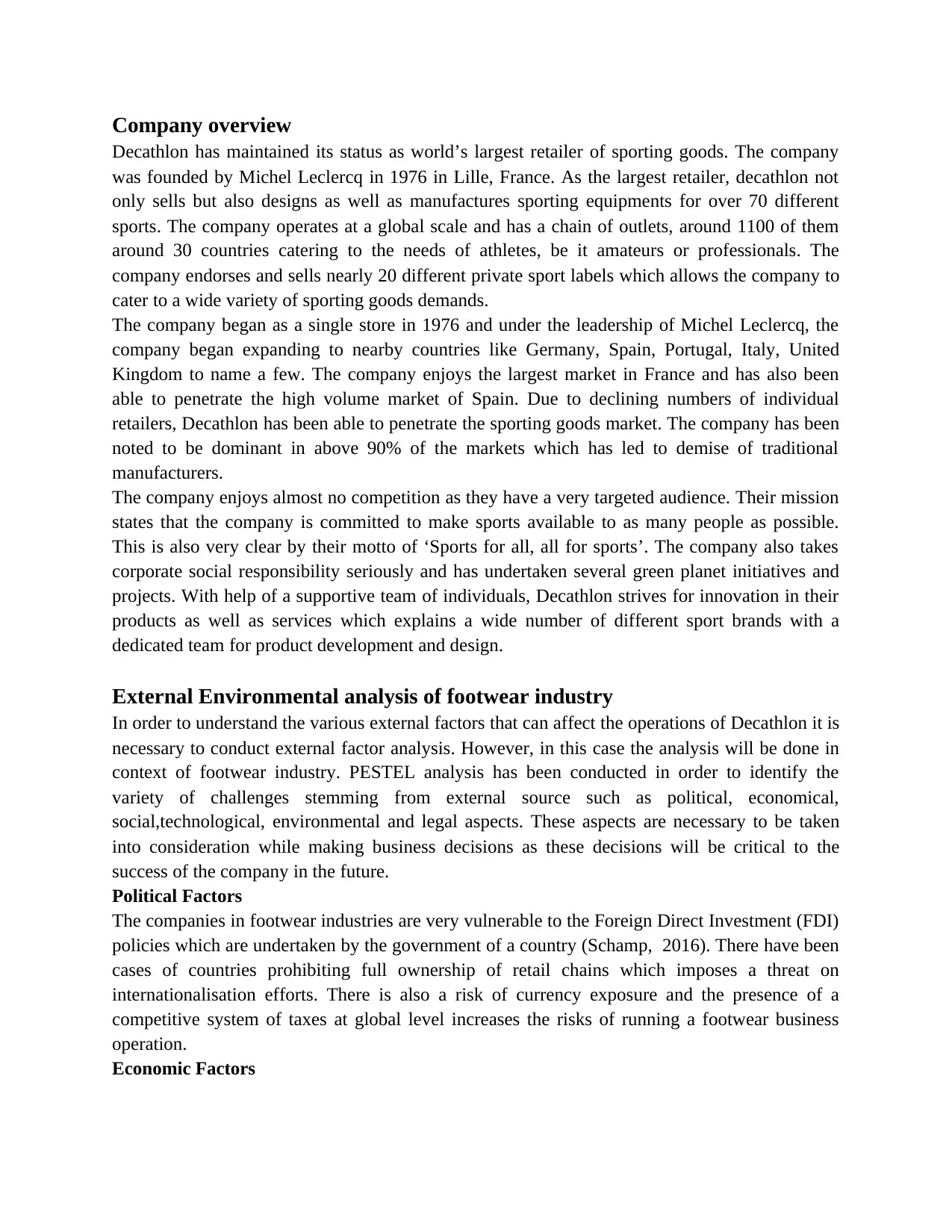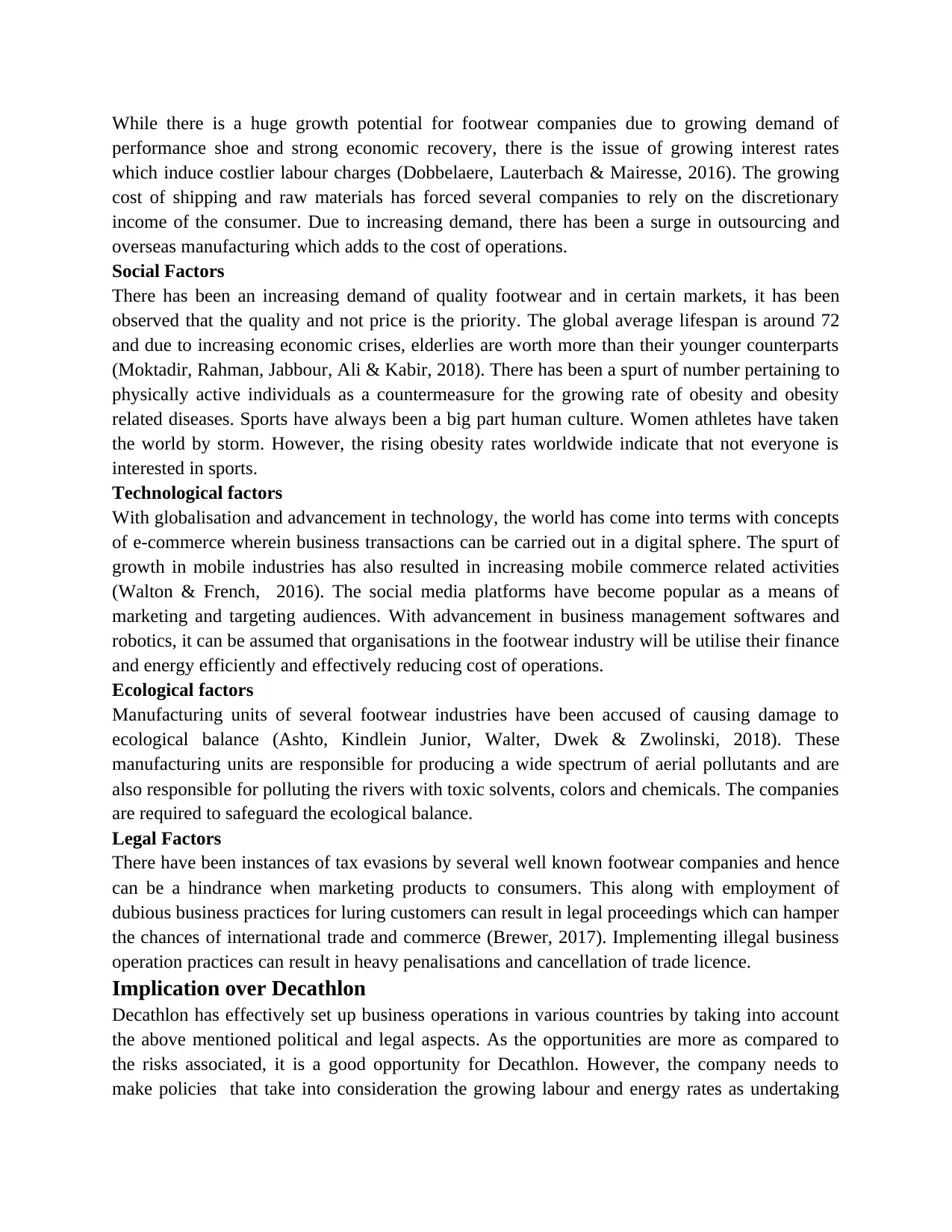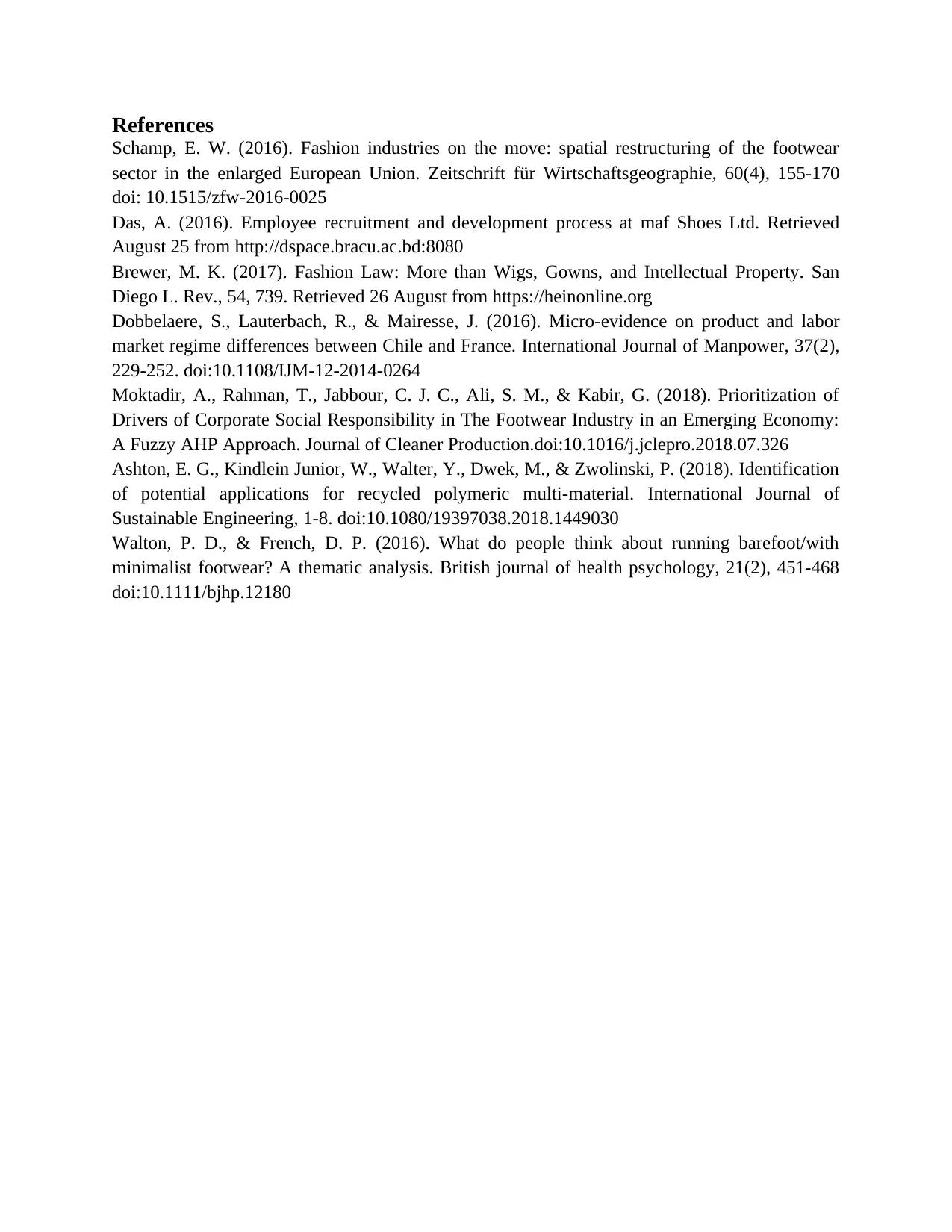PESTLE Analysis of Footwear Industry - Implications for Decathlon
VerifiedAdded on 2023/06/07
|6
|1445
|211
AI Summary
This article provides a PESTLE analysis of the footwear industry, highlighting the political, economic, social, technological, ecological, and legal factors that can affect the operations of Decathlon. The article also discusses the implications of these factors for Decathlon.
Contribute Materials
Your contribution can guide someone’s learning journey. Share your
documents today.

PESTLE ANALYSIS OVER FOOTWEAR INDUSTRY
Secure Best Marks with AI Grader
Need help grading? Try our AI Grader for instant feedback on your assignments.

Table of Contents

Company overview
Decathlon has maintained its status as world’s largest retailer of sporting goods. The company
was founded by Michel Leclercq in 1976 in Lille, France. As the largest retailer, decathlon not
only sells but also designs as well as manufactures sporting equipments for over 70 different
sports. The company operates at a global scale and has a chain of outlets, around 1100 of them
around 30 countries catering to the needs of athletes, be it amateurs or professionals. The
company endorses and sells nearly 20 different private sport labels which allows the company to
cater to a wide variety of sporting goods demands.
The company began as a single store in 1976 and under the leadership of Michel Leclercq, the
company began expanding to nearby countries like Germany, Spain, Portugal, Italy, United
Kingdom to name a few. The company enjoys the largest market in France and has also been
able to penetrate the high volume market of Spain. Due to declining numbers of individual
retailers, Decathlon has been able to penetrate the sporting goods market. The company has been
noted to be dominant in above 90% of the markets which has led to demise of traditional
manufacturers.
The company enjoys almost no competition as they have a very targeted audience. Their mission
states that the company is committed to make sports available to as many people as possible.
This is also very clear by their motto of ‘Sports for all, all for sports’. The company also takes
corporate social responsibility seriously and has undertaken several green planet initiatives and
projects. With help of a supportive team of individuals, Decathlon strives for innovation in their
products as well as services which explains a wide number of different sport brands with a
dedicated team for product development and design.
External Environmental analysis of footwear industry
In order to understand the various external factors that can affect the operations of Decathlon it is
necessary to conduct external factor analysis. However, in this case the analysis will be done in
context of footwear industry. PESTEL analysis has been conducted in order to identify the
variety of challenges stemming from external source such as political, economical,
social,technological, environmental and legal aspects. These aspects are necessary to be taken
into consideration while making business decisions as these decisions will be critical to the
success of the company in the future.
Political Factors
The companies in footwear industries are very vulnerable to the Foreign Direct Investment (FDI)
policies which are undertaken by the government of a country (Schamp, 2016). There have been
cases of countries prohibiting full ownership of retail chains which imposes a threat on
internationalisation efforts. There is also a risk of currency exposure and the presence of a
competitive system of taxes at global level increases the risks of running a footwear business
operation.
Economic Factors
Decathlon has maintained its status as world’s largest retailer of sporting goods. The company
was founded by Michel Leclercq in 1976 in Lille, France. As the largest retailer, decathlon not
only sells but also designs as well as manufactures sporting equipments for over 70 different
sports. The company operates at a global scale and has a chain of outlets, around 1100 of them
around 30 countries catering to the needs of athletes, be it amateurs or professionals. The
company endorses and sells nearly 20 different private sport labels which allows the company to
cater to a wide variety of sporting goods demands.
The company began as a single store in 1976 and under the leadership of Michel Leclercq, the
company began expanding to nearby countries like Germany, Spain, Portugal, Italy, United
Kingdom to name a few. The company enjoys the largest market in France and has also been
able to penetrate the high volume market of Spain. Due to declining numbers of individual
retailers, Decathlon has been able to penetrate the sporting goods market. The company has been
noted to be dominant in above 90% of the markets which has led to demise of traditional
manufacturers.
The company enjoys almost no competition as they have a very targeted audience. Their mission
states that the company is committed to make sports available to as many people as possible.
This is also very clear by their motto of ‘Sports for all, all for sports’. The company also takes
corporate social responsibility seriously and has undertaken several green planet initiatives and
projects. With help of a supportive team of individuals, Decathlon strives for innovation in their
products as well as services which explains a wide number of different sport brands with a
dedicated team for product development and design.
External Environmental analysis of footwear industry
In order to understand the various external factors that can affect the operations of Decathlon it is
necessary to conduct external factor analysis. However, in this case the analysis will be done in
context of footwear industry. PESTEL analysis has been conducted in order to identify the
variety of challenges stemming from external source such as political, economical,
social,technological, environmental and legal aspects. These aspects are necessary to be taken
into consideration while making business decisions as these decisions will be critical to the
success of the company in the future.
Political Factors
The companies in footwear industries are very vulnerable to the Foreign Direct Investment (FDI)
policies which are undertaken by the government of a country (Schamp, 2016). There have been
cases of countries prohibiting full ownership of retail chains which imposes a threat on
internationalisation efforts. There is also a risk of currency exposure and the presence of a
competitive system of taxes at global level increases the risks of running a footwear business
operation.
Economic Factors

While there is a huge growth potential for footwear companies due to growing demand of
performance shoe and strong economic recovery, there is the issue of growing interest rates
which induce costlier labour charges (Dobbelaere, Lauterbach & Mairesse, 2016). The growing
cost of shipping and raw materials has forced several companies to rely on the discretionary
income of the consumer. Due to increasing demand, there has been a surge in outsourcing and
overseas manufacturing which adds to the cost of operations.
Social Factors
There has been an increasing demand of quality footwear and in certain markets, it has been
observed that the quality and not price is the priority. The global average lifespan is around 72
and due to increasing economic crises, elderlies are worth more than their younger counterparts
(Moktadir, Rahman, Jabbour, Ali & Kabir, 2018). There has been a spurt of number pertaining to
physically active individuals as a countermeasure for the growing rate of obesity and obesity
related diseases. Sports have always been a big part human culture. Women athletes have taken
the world by storm. However, the rising obesity rates worldwide indicate that not everyone is
interested in sports.
Technological factors
With globalisation and advancement in technology, the world has come into terms with concepts
of e-commerce wherein business transactions can be carried out in a digital sphere. The spurt of
growth in mobile industries has also resulted in increasing mobile commerce related activities
(Walton & French, 2016). The social media platforms have become popular as a means of
marketing and targeting audiences. With advancement in business management softwares and
robotics, it can be assumed that organisations in the footwear industry will be utilise their finance
and energy efficiently and effectively reducing cost of operations.
Ecological factors
Manufacturing units of several footwear industries have been accused of causing damage to
ecological balance (Ashto, Kindlein Junior, Walter, Dwek & Zwolinski, 2018). These
manufacturing units are responsible for producing a wide spectrum of aerial pollutants and are
also responsible for polluting the rivers with toxic solvents, colors and chemicals. The companies
are required to safeguard the ecological balance.
Legal Factors
There have been instances of tax evasions by several well known footwear companies and hence
can be a hindrance when marketing products to consumers. This along with employment of
dubious business practices for luring customers can result in legal proceedings which can hamper
the chances of international trade and commerce (Brewer, 2017). Implementing illegal business
operation practices can result in heavy penalisations and cancellation of trade licence.
Implication over Decathlon
Decathlon has effectively set up business operations in various countries by taking into account
the above mentioned political and legal aspects. As the opportunities are more as compared to
the risks associated, it is a good opportunity for Decathlon. However, the company needs to
make policies that take into consideration the growing labour and energy rates as undertaking
performance shoe and strong economic recovery, there is the issue of growing interest rates
which induce costlier labour charges (Dobbelaere, Lauterbach & Mairesse, 2016). The growing
cost of shipping and raw materials has forced several companies to rely on the discretionary
income of the consumer. Due to increasing demand, there has been a surge in outsourcing and
overseas manufacturing which adds to the cost of operations.
Social Factors
There has been an increasing demand of quality footwear and in certain markets, it has been
observed that the quality and not price is the priority. The global average lifespan is around 72
and due to increasing economic crises, elderlies are worth more than their younger counterparts
(Moktadir, Rahman, Jabbour, Ali & Kabir, 2018). There has been a spurt of number pertaining to
physically active individuals as a countermeasure for the growing rate of obesity and obesity
related diseases. Sports have always been a big part human culture. Women athletes have taken
the world by storm. However, the rising obesity rates worldwide indicate that not everyone is
interested in sports.
Technological factors
With globalisation and advancement in technology, the world has come into terms with concepts
of e-commerce wherein business transactions can be carried out in a digital sphere. The spurt of
growth in mobile industries has also resulted in increasing mobile commerce related activities
(Walton & French, 2016). The social media platforms have become popular as a means of
marketing and targeting audiences. With advancement in business management softwares and
robotics, it can be assumed that organisations in the footwear industry will be utilise their finance
and energy efficiently and effectively reducing cost of operations.
Ecological factors
Manufacturing units of several footwear industries have been accused of causing damage to
ecological balance (Ashto, Kindlein Junior, Walter, Dwek & Zwolinski, 2018). These
manufacturing units are responsible for producing a wide spectrum of aerial pollutants and are
also responsible for polluting the rivers with toxic solvents, colors and chemicals. The companies
are required to safeguard the ecological balance.
Legal Factors
There have been instances of tax evasions by several well known footwear companies and hence
can be a hindrance when marketing products to consumers. This along with employment of
dubious business practices for luring customers can result in legal proceedings which can hamper
the chances of international trade and commerce (Brewer, 2017). Implementing illegal business
operation practices can result in heavy penalisations and cancellation of trade licence.
Implication over Decathlon
Decathlon has effectively set up business operations in various countries by taking into account
the above mentioned political and legal aspects. As the opportunities are more as compared to
the risks associated, it is a good opportunity for Decathlon. However, the company needs to
make policies that take into consideration the growing labour and energy rates as undertaking
Secure Best Marks with AI Grader
Need help grading? Try our AI Grader for instant feedback on your assignments.

correct decisions will pave way for global success and establish the brand name. By evaluating
the concerns of the legal affairs in the field of the footwear, Decathlon have eventually set up
operation of employee benefits and other customer support rules (Das, 2016). With presentation
of the above regulation in the organization, Decathlon is bound to observe positive change in its
business operation. The marketing department have considered the ecological factors and have
preferred the use of paper bags. This sense of environment friendliness has brought new well
wishing opportunities for the organization
the concerns of the legal affairs in the field of the footwear, Decathlon have eventually set up
operation of employee benefits and other customer support rules (Das, 2016). With presentation
of the above regulation in the organization, Decathlon is bound to observe positive change in its
business operation. The marketing department have considered the ecological factors and have
preferred the use of paper bags. This sense of environment friendliness has brought new well
wishing opportunities for the organization

References
Schamp, E. W. (2016). Fashion industries on the move: spatial restructuring of the footwear
sector in the enlarged European Union. Zeitschrift für Wirtschaftsgeographie, 60(4), 155-170
doi: 10.1515/zfw-2016-0025
Das, A. (2016). Employee recruitment and development process at maf Shoes Ltd. Retrieved
August 25 from http://dspace.bracu.ac.bd:8080
Brewer, M. K. (2017). Fashion Law: More than Wigs, Gowns, and Intellectual Property. San
Diego L. Rev., 54, 739. Retrieved 26 August from https://heinonline.org
Dobbelaere, S., Lauterbach, R., & Mairesse, J. (2016). Micro-evidence on product and labor
market regime differences between Chile and France. International Journal of Manpower, 37(2),
229-252. doi:10.1108/IJM-12-2014-0264
Moktadir, A., Rahman, T., Jabbour, C. J. C., Ali, S. M., & Kabir, G. (2018). Prioritization of
Drivers of Corporate Social Responsibility in The Footwear Industry in an Emerging Economy:
A Fuzzy AHP Approach. Journal of Cleaner Production.doi:10.1016/j.jclepro.2018.07.326
Ashton, E. G., Kindlein Junior, W., Walter, Y., Dwek, M., & Zwolinski, P. (2018). Identification
of potential applications for recycled polymeric multi-material. International Journal of
Sustainable Engineering, 1-8. doi:10.1080/19397038.2018.1449030
Walton, P. D., & French, D. P. (2016). What do people think about running barefoot/with
minimalist footwear? A thematic analysis. British journal of health psychology, 21(2), 451-468
doi:10.1111/bjhp.12180
Schamp, E. W. (2016). Fashion industries on the move: spatial restructuring of the footwear
sector in the enlarged European Union. Zeitschrift für Wirtschaftsgeographie, 60(4), 155-170
doi: 10.1515/zfw-2016-0025
Das, A. (2016). Employee recruitment and development process at maf Shoes Ltd. Retrieved
August 25 from http://dspace.bracu.ac.bd:8080
Brewer, M. K. (2017). Fashion Law: More than Wigs, Gowns, and Intellectual Property. San
Diego L. Rev., 54, 739. Retrieved 26 August from https://heinonline.org
Dobbelaere, S., Lauterbach, R., & Mairesse, J. (2016). Micro-evidence on product and labor
market regime differences between Chile and France. International Journal of Manpower, 37(2),
229-252. doi:10.1108/IJM-12-2014-0264
Moktadir, A., Rahman, T., Jabbour, C. J. C., Ali, S. M., & Kabir, G. (2018). Prioritization of
Drivers of Corporate Social Responsibility in The Footwear Industry in an Emerging Economy:
A Fuzzy AHP Approach. Journal of Cleaner Production.doi:10.1016/j.jclepro.2018.07.326
Ashton, E. G., Kindlein Junior, W., Walter, Y., Dwek, M., & Zwolinski, P. (2018). Identification
of potential applications for recycled polymeric multi-material. International Journal of
Sustainable Engineering, 1-8. doi:10.1080/19397038.2018.1449030
Walton, P. D., & French, D. P. (2016). What do people think about running barefoot/with
minimalist footwear? A thematic analysis. British journal of health psychology, 21(2), 451-468
doi:10.1111/bjhp.12180
1 out of 6
Related Documents
Your All-in-One AI-Powered Toolkit for Academic Success.
+13062052269
info@desklib.com
Available 24*7 on WhatsApp / Email
![[object Object]](/_next/static/media/star-bottom.7253800d.svg)
Unlock your academic potential
© 2024 | Zucol Services PVT LTD | All rights reserved.




